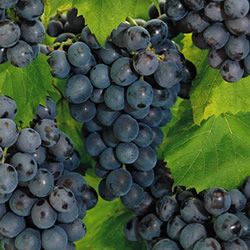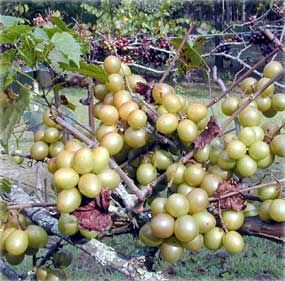|
|||||
|
|||||||
|
    An initiative of :Stichting Food-Info
|
| Food-Info.net> Food Products > Wine Species and Varieties of the Wine GrapeThe thousands of grape varieties that have been developed, with 5,000 reported for Vitis vinifera alone, differ from one another in such characteristics as colour, size, and shape of berry; juice composition (including flavour); ripening time, and disease resistance. They are grown under widely varying climatic conditions, and many different processes are applied in producing wines from them. All of these possible variations contribute to the vast variety of wines available.
|
||||||||
 |
 |
V.labrusca (Source) |
V.rotundifolia (Source) |
The grapevine, although primarily a temperate-zone plant, can grow under semi-tropical conditions. It is not adapted to the cooler parts of the temperate zone, where growing seasons may be too short to allow the fruit to reach maturity or where low winter temperatures (less than -7°C) may kill the vine or its fruitful buds. V. vinifera is more susceptible to damage from winter conditions than V. labrusca.
Climate strongly influences the composition of mature grapes. A major cause of the variation among grapes from different areas is the differing quantities of heat received by the vines during the growing season. Other important factors include differences in night and day temperature, hours of exposure to sunlight, and soil temperature.
Grapes begin their growth cycle in the spring when the average daily temperature is about 10°C. To reach maturity, they require a certain amount of heat above 10°C during the growing season. This amount of heat, called the heat summation, is calculated by totalling the value of average daily temperatures over 10°C for each day of the growing season. A heat summation of about 1,800 is required for successful growth. If the heat summation is less than required, the grapes will not ripen; they will reach the end of the growing season with insufficient sugar and too much acidity. This situation, frequently occurring in the eastern United States, Switzerland, and other cool regions, can be corrected by adding sugar to the crushed grapes. Where the heat summation is much greater than required, as in Algeria and parts of California, the grapes mature earlier and with less acidity and colour than those produced under cooler conditions.
Factors influencing the heat summation of a vineyard and, therefore, grape composition include exposure (in Europe, best from the east), air drainage (preferably from the slopes to the valley), soil temperature (above 10°C during the growing season), and soil moisture content (not too dry at any time and not waterlogged for more than short periods).
Seasonal conditions can also be critical, especially in regions of low heat summation, as found in parts of France and Germany. When the growing season in such areas is warmer than usual, the fruit produced is riper and better balanced than is usual in cool seasons. In warm regions, the sweeter dessert wines may benefit from somewhat low heat summation, resulting in less berry raisining (moisture loss) and giving the fruit better colour and acidity than is achieved when the growing season is excessively warm.
Such cultivation practices as weeding and pruning may also influence the mature fruit composition. Although the composition of the soil has an influence on soil temperature, root penetration, water-holding capacity and vine nutrition, its effect on the quality of wine, varying from region to region, is poorly understood.
Further reading :
More wine info: